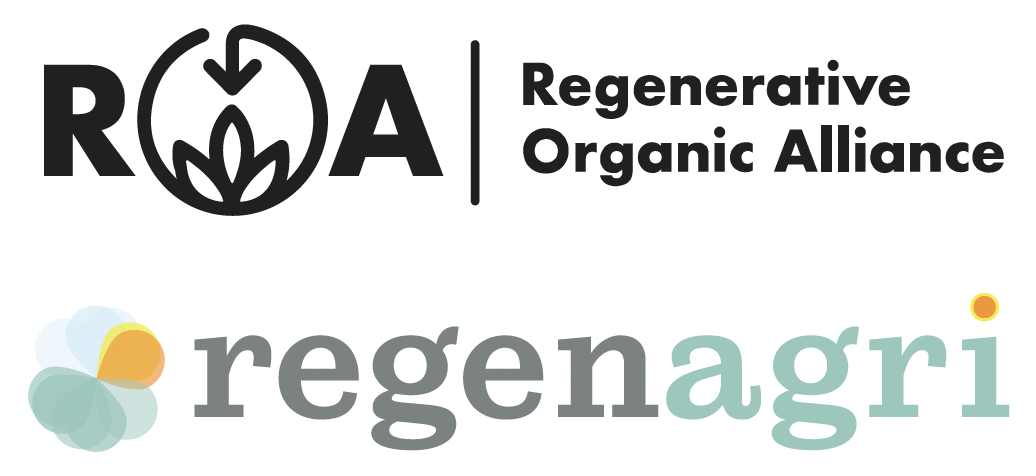Above: Over the next four years, Edacious will work closely with the ROA to identify…
Introducing the Journey to ROC™
The Regenerative Organic Alliance (ROA), steward of one of the most stringent standards for soil health, animal welfare, and social fairness, has launched the Journey to ROC™ initiative, a program designed to guide farmers and brands on a structured path toward achieving Regenerative Organic Certified® (ROC™) status.
To operationalize this, ROA has partnered with Regenagri, a global regenerative agriculture certification framework active in more than 30 countries and 330,000+ farms, covering both food and fiber systems. Together, the organizations will provide farmers and supply chains with clear, time-bound pathways and verified milestones that recognize meaningful progress toward regenerative organic practice.
How the Journey to ROC™ Works: The Farmer’s 3 – 5 Year Path
YEAR 1
Regenagri standards and systems plan
Regenagri Certification
Registration with ROA to monitor program progress and support for Market Access
ROA Engagement for progress monitoring and market support.
YEARS 2 – 5
Continuous improvement
Maintain Regenagri Certification with continuous improvement on
farm plans.
Regenerative Organic Systems Plan.
ROA Engagement continues to
build awareness and Market Access.
FINAL STEP
Certification with ROC™
Certified organic with soil health, animal welfare and social fairnesswith continuous improvement on farm plans.
ROA engagment to monitor program progress, build awareness and market access.

Benefits for farmers and brands
Market Access
Access to growing markets where regenerative organic products are in high demand.
Roadmap
A clear, time‑bound roadmap toward ROC™ certification.
Verification
Third-party verification of their regenerative progress.
Support
Guidance, tools, and support for continuous improvement.
Cost Efficiency
A pathway that reduces certification overlap and cost.
The ambition:
Scaling global regeneration
The Journey to ROC™ helps bring more authentic regenerative products to market — products that are better for people, animals, and the planet. For the broader movement, it advances the shift toward regenerative and organic agriculture worldwide, reinforcing credibility and transparency.
Our shared ambition is to scale regenerative and organic agriculture globally, empowering farms of all sizes to take part while maintaining the highest standards. By joining forces, ROA and Regenagri aim to expand access, strengthen traceability, and inspire a thriving global community of regenerative farmers, brands, and consumers united by a common goal: regenerating the health of our soil, our communities, and our planet.
Brands play a critical role in supporting the transition:
Establish License: Secure a License with Regenagri (Years 1 – 5).
Support Farm Program: Support Farm Program with Market Access to implement Regenerative Organic Systems Plans.
Financial Support: Offer financial support to offset farmers’ out-of-pocket costs (soil tests, data collection, certification costs, etc.).
ROA Membership: Join the Regenerative Organic Alliance (ROA) to monitor program progress and support Strategy and Market Access.
Get involved in the 2025 – 2026 pilot
Phase 1 — Pilot (2025 – 2026):
We are seeking 8 – 10 pilots across different geographic regions and agricultural systems.
Key farmer criteria:
Farmers must be able/willing to commit to a long‑term strategy that leads to ROC™.
Must have a brand or market partner that will support the program, specifically the out-of-pocket expenses that a farmer will incur during transition (ex: soil tests, data collection, certification, etc.) along with the purchase of certified regenerative products enrolled in the program.
Phase 2 — Program expansion
Phase 2 will onboard additional regenerative standards that align with ROA criteria, ensuring broader adoption and credibility.
Through the ROA Regenerative Farmers Fund, we can help offset out-of-pocket costs for farmers by implementing cost-sharing mechanisms. This approach reduces financial barriers, supports scaling, and enables more producers to transition into regenerative organic systems.
Interested in becoming involved?
